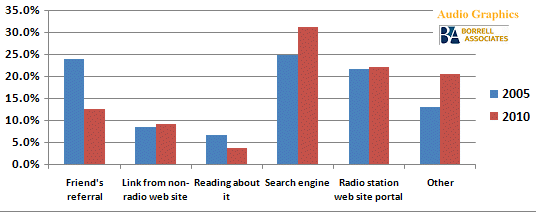 Analytics, Metrics and Music for the Radio Industry
Analytics, Metrics and Music for the Radio Industry
 An Indie Artist Pipeline to Internet Radio
An Indie Artist Pipeline to Internet Radio
 Radio Industry ROI Strategy
Radio Industry ROI Strategy
 A New Breed of Indie Artists
A New Breed of Indie Artists
Radio: To Be Found Or Not To Be Found
The radio industry is showing new energy at NAB in Las Vegas this week. It appears that digital radio is now targeted as the place to be, with many people trying harder to understand what "being online" means.
It's confusing, to be sure. From a broadcaster's mind, moving online is a simple task of building a web site, retransmitting your over-the-air signal as a stream, and establishing rates for the ads served on both.
The reality is that being online contains a few dozen more necessary elements - site navigation, search engine ranking, metrics, analytics, reporting, load time, copyright rates, recordkeeping, apps, etc. It's in these details that the industry needs to be focusing its new energy. Most difficult is not losing sight of radio's primary goal: delivering broadcast programming to its local audience.
| "...ask why it is that CBS's Radio.com, Clear Channel's iheartradio, or Emmis' online stations cannot find a place among among the top 10 from any of the 25 radio-related keywords listed here..." |
Rather than risk an eyeball glazefest by explaining everything today, let's look at one item: being highly ranked on search engines. This is a must if you want to grow an online audience. Currently, radio stations appearing in the top 10 for major radio-related keyword searches are scarce. If a radio station or radio group wishes to expand its online audience past the local Area of Dominant Influence (ADI), the most efficient approach is to be where people seeking online radio stations mostly go - search engines. |
We discussed this on March 7, but let's briefly revisit the topic today. Also, let's look at Audio Graphics' metrics that help display how much of your audience could come via search engine referral.
The graph represents reponse to a February 2010 Audio Graphics/Borrell Associates poll of online radio listeners, compared to that for the same question asked in 2005: "What most helps you find new Internet radio stations?"

Rather than go into a list of which web sites appear at the top of each keyword search (done March 7), this time let's look at what percentage of audience is driven to RadioRow, and where this web site appears (relative to the percentage of times it is in the number 1,2,3,4,5, etc. rankings).
From the tracking that I do it's safe to say RadioRow appears more times in the top-ten positions, for these 25 keyword returns, than any radio-related web site. (Though, Live365 runs a close race.) In the last 30 days, 80.4% of RadioRow's traffic was generated by search engine referral - all at no cost to Audio Graphics.
More specifically, relative to the Search Engine Return Page (SERP), RadioRow ranks in the following positions these pecentages of times:
| Keyword Rank |  | # of times appearing - Out of 75 Positions |  | % of times appearing at this rank, through 25 keywords | ||
| Position #1 |  | 24 |  | 32% | ||
| #2 |  | 6 |  | 8% | ||
| #3 |  | 8 |  | 10.6% | ||
| #4 |  | 7 |  | 2.6% | ||
| #5 |  | 8 |  | 10.6% | ||
| #6 |  | 2 |  | 2.6% | ||
| #7 |  | 7 |  | 9.3% | ||
| #8 |  | 1 |  | 1.3% | ||
| #9 |  | 2 |  | 2.6% | ||
| #10 |  | 5 |  | 6.6% | ||
| #13 |  | 2 |  | 2.6% | ||
| #18 |  | 1 |  | 1.3% | ||
| #19 |  | 1 |  | 1.3% | ||
| #24 |  | 1 |  | 1.3% |
As you go over these stats, ask why it is that CBS's Radio.com, Clear Channel's iheartradio, or Emmis' online station list cannot find a place among among the top 10 from any of the 25 radio-related keywords listed here; in fact, no commercial group's list of radio stations is anywhere to be found.
If radio is serious about gaining ground by growing its online audience, it's not going to be done simply by saying a radio station's URL more often over the air. Search engine optimization must be integrated into radio's daily online agenda.
Now that the radio industry has acknowledged integrating "online" as a must for its future, it should start placing efforts in areas that help grow its online audience.
To be found or not to be found? It's one of the most important questions radio can address today.








